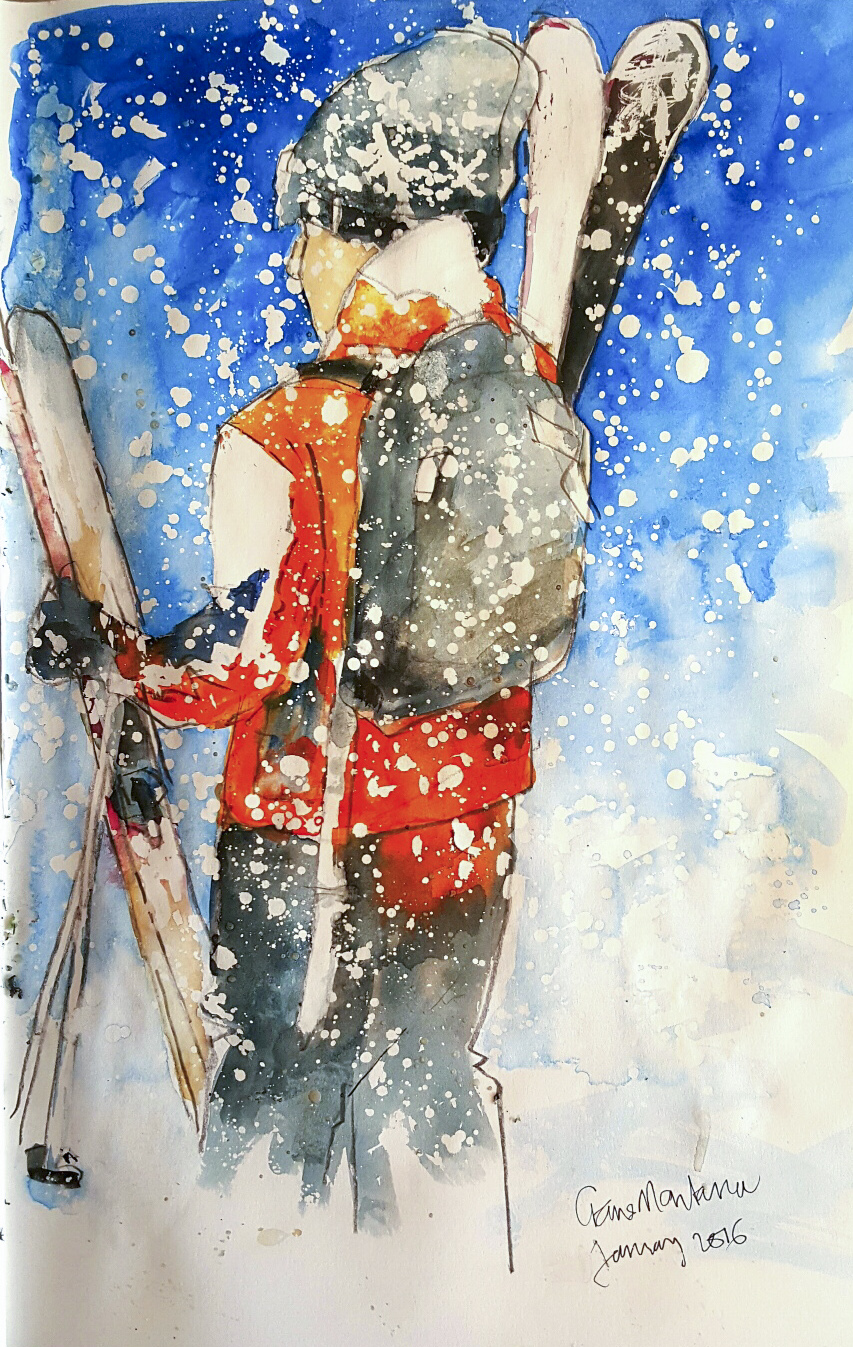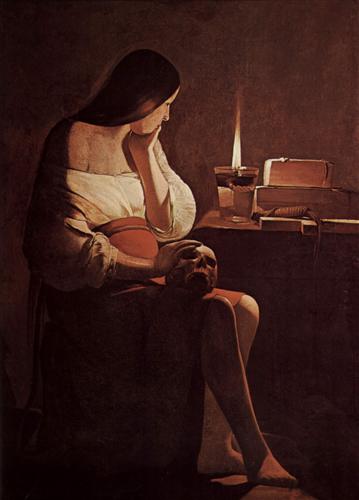TASIS Fine Arts Department Chair Martyn Dukes brought not only skis, but also his brushes and paints to this year's Ski Week in Crans Montana. The snow-filled days did nothing to diminish his creativity. Using both photographs and sketches of TASIS students enjoying the slopes, he then produced a series of watercolors. Almost everyone takes photographs while on ski week, but these four paintings seem to capture the essence of a week in the mountains even better.
Exploration of Chiaroscuro in Drawing and Painting
The History of Art teaches us many useful things about technique. Students in drawing and painting have been studying how chiaroscuro has played its part in the development of the tradition of Western painting by putting it to use in their studio work.
Chiaroscuro comes from the Italian and translates literally as, light/dark. In painting, it is the technique that allows an artist to describe form by graduations of light and dark and is generally accepted as being developed through the works of Leonardo de Vinci and his contemporaries during the Renaissance.
Chiaroscuro not only reveals form on a flat surface – the illusion of 3 dimensions - but also introduces an expressive element into the subject matter. When a single light source is used in a painting, for example a candle, or lamp, it creates strong contrast, with deep shadows and pools of light. These in turn add a sense of theatre, with the spectator drawn further into the work
Interesting fact: a grid used in this way dates from before the Renaissance. For most artists, including Leonardo De Vinci, a grid, along with a camera obscura, were everyday pieces of equipment in the artist’s copying “toolkit”.
During the C17th, Caravaggio, in Italy, Georges de la Tour, in Lorraine and Garrit van Honthurst, in Holland fully exploited this technique in their painting and through it, the subjects that inhabited them, was brought to life. Many of Caravaggio’s early biblical scenes actually caused a public outcry at the time because of their realistic and dramatic nature.
Students were asked to make larger than life self-portrait using white chalk on black Ingres paper. They had access to a single light source in a darkened space, a camera, and used a grid to enlarge and realise their final artwork.
(Click on the artwork below for information on each student artist.)
A Visit to Vitra
Our annual A&D trip to the Vitra campus and Design Museum included 25 of us on the November 20th weekend. We visited the Tadao Ando Conference Center and the new factory building by SANAA under the expert guidance of our Vitra guide Mrs. Jost, who is especially knowledgeable about Ando, Japanese architecture, and the history of the Vitra company. The experiential aspect of the trip is always a student favorite: it's impossible to over-estimate the importance of actually 'being there.' The trip went slightly later in the semester this year, allowing us to see the Bauhaus exhibition at the Design Museum. The Bauhaus was an idealistic German art school open between 1919 and 1933 where the goal was the unity of the arts. The focus of Bauhaus instruction shifted slightly over time from craftsmanship to industrial production to architecture, but the core principles of the Bauhaus education remained the same. The preliminary course, taught by famous 20th-century artist / teachers Paul Klee, Vassily Kandinsky, and Josef Albers (among others) emphasized materials, color theory, and formal relationships. Following this initial year, students specialized in one of the disciplines offered, such as metalworking, cabinetmaking, pottery, typography, and wall painting. The school adopted the slogan "Art into Industry" as an expression of its core ideals.
This community of purpose striving for a unity of the arts was truly admirable, as was theBauhaus emphasis on craftsmanship. Both Eliel Saarinen, who taught at Cranbrook Academy of Art, and Charles Eames, the California-based American designer, shared this idea of the centrality of the arts in human life. Students in the A&D classes try to be as mindful as possible about Saarinen's and Eames's ideas as they design their own chairs and houses. Vitra continues the Bauhaus tradition in its dedication to beauty, comfort, and design unity. (Written by Mark Aeschliman, Faculty)
Popcorn with Mr. Long
There is never enough time in the school year to watch all the inspirational DVDs and movies about photography. The Visual Arts department has a great collection of movies, and each year only one or two are watched during an actual class period. With the "In the Frame" movie nights, Mr. Long and Mrs. Nelson want to invite all photography students and all interested faculty and students to join us for Monday Night at the Movies. For the 2015-2016 series we have selected three films so far. Refreshments will be served!
Exquisite Corpse
Earlier this year TASIS Headmaster Lyle Rigg approached the TASIS photography faculty about a project he thought students might like to try. It was called the Exquisite Corpse. Needless to say TASIS photography teachers Frank Long and Kim Nelson were intrigued. Lyle shared a book by the Maine Media Workshop + College where his daughter Karin Leuthy is the Development Coordinator, and where he serves as a board member. Karin introduced the project to her organization as an interesting way to get many artists to work on a collaborative project. The Maine Media Workshops + College invited its own community of world-renowned artists to collaborate with other artists to create "exquisite corpses". View a video of their finished product here: Exquisite Corpse MMW.
The parlor game Exquisite Corpse developed from a Surrealist working of a game called “Consequences” in which players write in turn on a sheet of paper and fold the paper to conceal part of the writing before passing it on to the next contributor. In our Exquisite Corpse, the first player was given a phrase from which they were asked to produce an image. In turn that image was delivered to the next person and so on until each photographer had a chance to respond. Like a visual game of “Telephone,” participants add an image to the chain while only knowing the image that came before their own.
The images in each of these chains are not a collection, but rather a kind of story, told one image at a time, from multiple points of view. The beauty of the stories lie directly in the surprises, mystery, and disconnects that mark the trajectory of each narrative. The serendipity and strange, illogical juxtapositions are what attracted the Surrealists to the form. The excitement of creation and collaboration is what drives us to seek what the unknown will bring us at the end of our chain.
Please enjoy our initial Exquisite Corpse stories created by the students of our Advanced Photography courses (IB first and second year/Photography 2/Advanced Placement). Click on the title of each story and use the arrow on the right to follow the story sequentially.
Simona Bellini takes part in local exhibition
TASIS Visual Art Faculty member, Simona Bellini, is part of a two-person exhibition opening November 6 and running through December 8. The exhibition is entitled 'A partir dal seme' or 'To start from the seed'. For more information, please view the information below or download the flyer here.
A Visit to Riva San Vitale
On October 23rd, as he does almost every year, Mark Aeschliman made the short trip from TASIS to Riva San Vitale with his students to visit the Baptistry of San Giovanni, a 5th Century stone building, the oldest in Switzerland.
In his Architecture class and in his IB Visual Arts course, the students have studied the octagonal structure and have constructed models from card stock. Working from images and drawings of the baptistry, they create and reproduce in color and texture the stone exterior of the building. The visit to Riva San Vitale affords the opportunity to see the actual site and to study first hand the details of the stone exterior as well as the important features of the interior, from the stone baptismal font to the wall painting remnants that date to the12th Century.
Later in November, Mr. Aeschliman will take his students to Basel and to the Vitra Design Campus where they can see firsthand the architecture and design work of many of the 20th and some of the 21st century’s leading creative minds, from Charles and Ray Eames to Frank Gehry and Zaha Hadid among many others, whose work is shown in the form of buildings on site and furniture in the design museum.
Visit this link read more about Riva San Vitale and to view a 360º panorama of the Riva San Vitale Baptistery.























































